Activity 中的 setContentView
getWindow().setContentView(layoutResID);
initWindowDecorActionBar();
}setContentView 方法如下所示,调用的是 window 中的 setContentView,但是 window 中的只是一个抽象方法:
public abstract void setContentView(View view, ViewGroup.LayoutParams params);而在 window 类的最开始也说了,window 唯一的实现类是 PhoneWindow。所以这里调用的是 PhoneWindow 中的 setContentView,如下:
public void setContentView(int layoutResID) {
//父容器如果为 null 则进行创建
if (mContentParent == null) {
installDecor();
} else if (!hasFeature(FEATURE_CONTENT_TRANSITIONS)) {
mContentParent.removeAllViews();
}
if (hasFeature(FEATURE_CONTENT_TRANSITIONS)) {
final Scene newScene = Scene.getSceneForLayout(mContentParent, layoutResID,
getContext());
transitionTo(newScene);
} else {
//将传入的资源Id 加载到 mContentParent 上
mLayoutInflater.inflate(layoutResID, mContentParent);
}
mContentParent.requestApplyInsets();
final Callback cb = getCallback();
if (cb != null && !isDestroyed()) {
cb.onContentChanged();
}
mContentParentExplicitlySet = true;
}
private void installDecor() {
mForceDecorInstall = false;
if (mDecor == null) {
// return new DecorView(context, featureId, this, getAttributes());
//最终会创建一个 DecorView 赋值给 mDecor
mDecor = generateDecor(-1);
//.....
} else {
mDecor.setWindow(this);
}
//mContentParent是一个 VeiwGroup
if (mContentParent == null) {
//最终会根据当前窗口样式加载一个资源文件,并且加载到 mDecor 中,
//并返回资源文件中 id 为: @android:id/content 的ViewGroup,类型为 FrameLayout
mContentParent = generateLayout(mDecor);
}
}
protected ViewGroup generateLayout(DecorView decor) {
// 获取自当前主题的数据
TypedArray a = getWindowStyle();
//.......
// 装饰 decor,判断当前窗口的属性,将符合条件的布局添加到 decor
int layoutResource;
int features = getLocalFeatures();
else if ((features & ((1 << FEATURE_PROGRESS) | (1 << FEATURE_INDETERMINATE_PROGRESS))) != 0
&& (features & (1 << FEATURE_ACTION_BAR)) == 0) {
layoutResource = R.layout.screen_progress;
} else if ((features & (1 << FEATURE_CUSTOM_TITLE)) != 0) {
//加载资源
layoutResource = R.layout.screen_custom_title;
} else if ((features & (1 << FEATURE_NO_TITLE)) == 0) {
layoutResource = res.resourceId;
layoutResource = R.layout.screen_title;
} else if ((features & (1 << FEATURE_ACTION_MODE_OVERLAY)) != 0) {
layoutResource = R.layout.screen_simple_overlay_action_mode;
} else {
layoutResource = R.layout.screen_simple;
}
mDecor.startChanging();
//调用 mDecor 的方法,将刚才找到的系统布局文件加载到 DecorView 中
mDecor.onResourcesLoaded(mLayoutInflater, layoutResource);
// ID_ANDROID_CONTENT 这个ID 就是资源文件中的 Id
//点开findViewById ,就可以看到里面用的 View 是 DecorView
ViewGroup contentParent = (ViewGroup)findViewById(ID_ANDROID_CONTENT);
if (contentParent == null) {
throw new RuntimeException("Window couldn't find content container view");
}
//......
mDecor.finishChanging();
return contentParent;
}在 setContentView 方法中,调用了 installDecor(),下面分析一下这个方法。
首先会创建一个 DecorView ,这是一个 继承子 FrameLayout 的View 。也就是说 Window 类中包含了一个 DecorView。
接着就会判断 mContentParent 是否为 null,如果为 null,就会调用 generateLayout 去创建,mContentParent 是一个 ViewGroup。在 generateLayout中会调用系统的资源,判断系统当前的窗口模式。然后加载对应的布局。最终就会将这个资源文件加载到 DecorView 中。并且会调用 findViewById 找到一个 ViewGroup,并返回,点开findViewById ,就可以看到里面用的 View 是 DecorView 。至于加载的是那个 id,如下所示:
一般情况下,加载的资源layout中都有会 framelayout 这个 View,并且可以看到 id 为 @android:id/content。你可以复制布局名称然后全局搜索查看一下这个布局。
布局如下:
android:layout_width="match_parent"
android:layout_height="match_parent"
android:fitsSystemWindows="true"
android:orientation="vertical">
到这里,installDecor()方法中比较重要的地方已经看完了。梳理一下:
在 setContentView() 中创建 DecorView ,接着根据系统窗口的类型获取到一个资源 layout。接着讲这个资源文件 加载到 DecorView 中,并 通过findViewById 获取了 资源文件中 id 为 @android:id/content 的控件,将其强转为 ViewGroup 并返回。
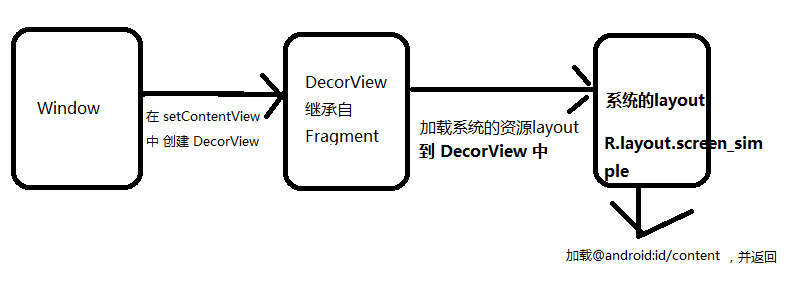
后期勘误:第二个框中:DecorView 是继承自 FrameLayout 的
在 setContentView 方法中,调用完 installDecor()方法后,往下还有非常重要的一句话
mLayoutInflater.inflate(layoutResID, mContentParent);这个 layoutResID 就是 调用 setContentView 时传入的。这里将这个资源加载到了 mContentParent 上面,通过上面的分析我们可以知道 contentParent 就是 DecorView 中 id 为 @android:id/content 的 Framelayout 布局。
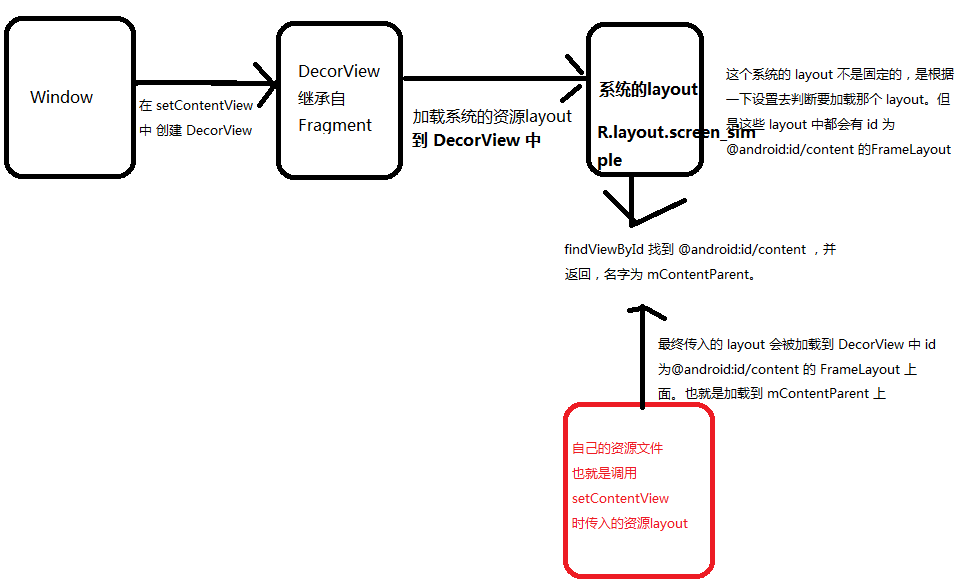
后期勘误:第二个框中:DecorView 是继承自 FrameLayout 的
最终大致的逻辑如上图
我们可以做一个测试,看一下我们分析的有没有问题:
super.onCreate(savedInstanceState)
// setContentView(layout())
val view = LayoutInflater.from(this).inflate(layout(), null)
val decorView = window.decorView
val frameLayout = decorView.findViewById(android.R.id.content)
frameLayout.addView(view)
}这是一个 activity 的 onCreate 方法,我注释掉了 setContentView 方法,并直接加载了一个布局。然后调用 window 中的 decorView。获取到其中的 frameLayout,然后将 布局添加进去。
最终运行显示的效果是正常的。
下面给一张图,清楚的展示了布局加载的流程
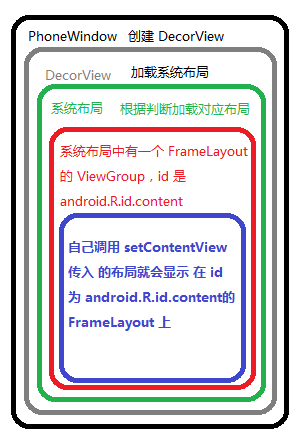
AppCompatActivity 中的 setContentView
其实相比于 Activity 的 setContentView 还是有一些区别。主要是为了兼容低版本的一些东西。
接下来就看一下源码吧
public void setContentView(View view, ViewGroup.LayoutParams params) {
getDelegate().setContentView(view, params);
}
@NonNull
public AppCompatDelegate getDelegate() {
if (mDelegate == null) {
mDelegate = AppCompatDelegate.create(this, this);
}
return mDelegate;
}
public static AppCompatDelegate create(Activity activity, AppCompatCallback callback) {
return new AppCompatDelegateImpl(activity, activity.getWindow(), callback);
}这里调用的 setContentView 也是一个抽象方法,最终调用的是 AppCompatDelegateImpl 中的
public void setContentView(View v) {
ensureSubDecor();
ViewGroup contentParent = (ViewGroup) mSubDecor.findViewById(android.R.id.content);
contentParent.removeAllViews();
contentParent.addView(v);
mOriginalWindowCallback.onContentChanged();
}
private void ensureSubDecor() {
if (!mSubDecorInstalled) {
mSubDecor = createSubDecor();
}
}
private ViewGroup createSubDecor() {
TypedArray a = mContext.obtainStyledAttributes(R.styleable.AppCompatTheme);
final LayoutInflater inflater = LayoutInflater.from(mContext);
//空的 ViewGroup
ViewGroup subDecor = null;
//根据一系列的判断,最后加载一个 layout 到 ViewGroup 上
if (!mWindowNoTitle) {
subDecor = (ViewGroup) inflater.inflate(
R.layout.abc_dialog_title_material, null);
} else if (mHasActionBar) {
subDecor = (ViewGroup) LayoutInflater.from(themedContext)
.inflate(R.layout.abc_screen_toolbar, null);
} else {
if (mOverlayActionMode) {
subDecor = (ViewGroup) inflater.inflate(
R.layout.abc_screen_simple_overlay_action_mode, null);
} else {
subDecor = (ViewGroup) inflater.inflate(R.layout.abc_screen_simple, null);
}
}
//获取 subDecor 中的id
final ContentFrameLayout contentView = (ContentFrameLayout) subDecor.findViewById(
R.id.action_bar_activity_content);
//这里获取的是 Window 中的 DecorView
final ViewGroup windowContentView = (ViewGroup) mWindow.findViewById(android.R.id.content);
if (windowContentView != null) {
//设置一个 空的 Id
windowContentView.setId(View.NO_ID);
//给 contentView 设置一个新的 id
contentView.setId(android.R.id.content);
}
//最终还是调用了 window 中的 setContentView 方法
// Now set the Window's content view with the decor
mWindow.setContentView(subDecor);
return subDecor;
}看流程,可以发现最终还是调用的 window 中的 setContentView,但是在这里有多了一层
他首先会创建一个ViewGroup,然后根据一系列的判断添加一个layout。最后调用 window 的 setContentView 。接着就会将我们传入的布局 添加到这个 ViewGroup 中,相比于 Activity。他中间多了一个 ViewGroup。
AppCompatActivity 的兼容性
一个小例子:新建一个 activity,在布局中创建一个 ImageView。
android:id="@+id/test_iv"
android:layout_width="match_parent"
android:layout_height="200dp"
android:layout_marginTop="50dp"
android:src="@drawable/image"/>接着让 activity 首先继承 Activity ,最后继承 AppCompatActivity,然后打印 ImageView
android.widget.ImageView
androidx.appcompat.widget.AppCompatImageView发现如果是继承自 AppcompatActivity,则 iamgeView 最终创建的是 AppCompatImageView ,具有兼容性的 ImageView。这个是为啥呢,下面分析一下源码:
源码分析:
首先在 AppCompatActivity 的 onCreate 方法中 调用了一个非常重要的方法,如下:
protected void onCreate(@Nullable Bundle savedInstanceState) {
final AppCompatDelegate delegate = getDelegate();
//安装View 的工厂,这里的 delegate 就是 AppCompatDelegateImpl
delegate.installViewFactory();
delegate.onCreate(savedInstanceState);
super.onCreate(savedInstanceState);
}AppCompatDelegateImpl 实现了一个接口 LayoutInflater.Factory2
public void installViewFactory() {
LayoutInflater layoutInflater = LayoutInflater.from(mContext);
if (layoutInflater.getFactory() == null) {
//把 LayoutInflater 的 Factory 设置为 this,也就是说创建 View 就会掉自己的 onCreateView 方法
//如果没看懂就看一下 LayoutInflater 的源码,LayoutInflater.from(mContext) 其实是一个单例
//如果设置了 Factory,那么每次创建 View 时都会先执行 onCreateView 方法
LayoutInflaterCompat.setFactory2(layoutInflater, this);
} else {
if (!(layoutInflater.getFactory2() instanceof AppCompatDelegateImpl)) {
Log.i(TAG, "The Activity's LayoutInflater already has a Factory installed"
+ " so we can not install AppCompat's");
}
}
}LayoutInflater.from(mContext) 其实是一个单例。他会将 LayoutInflater 的 Factory 设置为 this。
当我们在使用这种 : LayoutInflater.from(this).inflate(layout(), parent) 代码时,就会调用到 AppCompatDelegateImpl 类中 实现 LayoutInflater.Factory2的 onCreateView 方法,
@UnsupportedAppUsage(trackingBug = 122360734)
@Nullable
public final View tryCreateView(@Nullable View parent, @NonNull String name,
@NonNull Context context,
@NonNull AttributeSet attrs) {
if (name.equals(TAG_1995)) {
// Let's party like it's 1995!
}
View view;
if (mFactory2 != null) {
//这里,LayoutInflater.from(this).inflate(layout(), null),如果使用 AppCompatActivity ,就会给 mFactory2 设置一个值,最终这里就会调用到 AppCompatDelegateImpl 中的 onCreateView 中。
view = mFactory2.onCreateView(parent, name, context, attrs);
} else if (mFactory != null) {
view = mFactory.onCreateView(name, context, attrs);
} else {
view = null;
}
if (view == null && mPrivateFactory != null) {
view = mPrivateFactory.onCreateView(parent, name, context, attrs);
}
return view;
}
}通过上面可以看到 在使用 LayoutInflater.from(this).inflate(layout(), null) 时,是如何调用到 AppCompatDelegateImpl 中的 onCreateView 中的。
接着看一下 onCreateView
* From {@link LayoutInflater.Factory2}.
*/
@Override
public final View onCreateView(View parent, String name, Context context, AttributeSet attrs) {
return createView(parent, name, context, attrs);
}
@Override
public View createView(View parent, final String name, @NonNull Context context,
@NonNull AttributeSet attrs) {
//.......
return mAppCompatViewInflater.createView(parent, name, context, attrs, inheritContext, IS_PRE_LOLLIPOP, true, VectorEnabledTintResources.shouldBeUsed()
);
} @NonNull AttributeSet attrs, boolean inheritContext,
boolean readAndroidTheme, boolean readAppTheme, boolean wrapContext) {
final Context originalContext = context;
//.......
View view = null;
//在这里进行了替换
switch (name) {
case "TextView":
view = createTextView(context, attrs);
verifyNotNull(view, name);
break;
case "ImageView":
view = createImageView(context, attrs);
verifyNotNull(view, name);
break;
case "Button":
view = createButton(context, attrs);
verifyNotNull(view, name);
break;
case "EditText":
view = createEditText(context, attrs);
verifyNotNull(view, name);
break;
case "Spinner":
view = createSpinner(context, attrs);
verifyNotNull(view, name);
break;
case "ImageButton":
view = createImageButton(context, attrs);
verifyNotNull(view, name);
break;
case "CheckBox":
view = createCheckBox(context, attrs);
verifyNotNull(view, name);
break;
case "RadioButton":
view = createRadioButton(context, attrs);
verifyNotNull(view, name);
break;
case "CheckedTextView":
view = createCheckedTextView(context, attrs);
verifyNotNull(view, name);
break;
case "AutoCompleteTextView":
view = createAutoCompleteTextView(context, attrs);
verifyNotNull(view, name);
break;
case "MultiAutoCompleteTextView":
view = createMultiAutoCompleteTextView(context, attrs);
verifyNotNull(view, name);
break;
case "RatingBar":
view = createRatingBar(context, attrs);
verifyNotNull(view, name);
break;
case "SeekBar":
view = createSeekBar(context, attrs);
verifyNotNull(view, name);
break;
default:
// The fallback that allows extending class to take over view inflation
// for other tags. Note that we don't check that the result is not-null.
// That allows the custom inflater path to fall back on the default one
// later in this method.
view = createView(context, name, attrs);
}
return view;
}
//替换后的 AppComptImageView
@NonNull
protected AppCompatImageView createImageView(Context context, AttributeSet attrs) {
return new AppCompatImageView(context, attrs);
}最终将替换后的 View 进行返回
这里比较重要的是 View 的创建首先会走 mFactory2,然后才会走 mFactory,只要不会 null,就会执行 Factory 的 onCreateView 方法。否则最后就会走 系统的 createView 方法。
LayoutInflater
主要用来实例化我我们的 layout 布局
使用的方式
LayoutInflater.from(this).inflate(R.layout.activity_main,null) //2
LayoutInflater.from(this).inflate(R.layout.activity_main,null,false) //3public static View inflate(Context context, @LayoutRes int resource, ViewGroup root) {
LayoutInflater factory = LayoutInflater.from(context);
return factory.inflate(resource, root);
}
//2
public View inflate(@LayoutRes int resource, @Nullable ViewGroup root) {
return inflate(resource, root, root != null);
}
//3
public View inflate(@LayoutRes int resource, @Nullable ViewGroup root, boolean attachToRoot) {
//......
} 从源码中可以看到,第一种调用的是第二种,第二种调用的是第三种,根据有没有传入根布局来传入第三个参数。所以我们只需要看第三个方法就 ok
看一下 LayoutInflater.from()
LayoutInflater LayoutInflater =
(LayoutInflater) context.getSystemService(Context.LAYOUT_INFLATER_SERVICE);
return LayoutInflater;
}
############################# ContextImpl ############
@Override
public Object getSystemService(String name) {
return SystemServiceRegistry.getSystemService(this, name);
}
//一个静态的 Map
private static final Map> SYSTEM_SERVICE_FETCHERS =
new ArrayMap>();
public static Object getSystemService(ContextImpl ctx, String name) {
ServiceFetcher> fetcher = SYSTEM_SERVICE_FETCHERS.get(name);
return fetcher != null ? fetcher.getService(ctx) : null;
}可以看到这里拿到的是一个系统的服务
接着往下看就可以看到这个服务是从一个 静态的 Map 中获取的。那么这个 Map 是怎么初始化的呢?
ContextImpl 中有一个静态代码块,专门用来注册各种服务,LAYOUT_INFLATER_SERVICE 也是其中的一个。
由此我们可以得知 LayoutInflater.from(this) 是一个系统服务,并且他是一个单例。
接着看一下是怎样实例化 View 的
//获取资源文件
final Resources res = getContext().getResources();
//XmlResourceParser 的解析器
XmlResourceParser parser = res.getLayout(resource);
try {
return inflate(parser, root, attachToRoot);
} finally {
parser.close();
}
} synchronized (mConstructorArgs) {
Trace.traceBegin(Trace.TRACE_TAG_VIEW, "inflate");
//...........
//保存传进来的 Viwe
View result = root;
try {
advanceToRootNode(parser);
final String name = parser.getName();
//如果是 merge 标签 就调用 rInflate,否则执行 else
if (TAG_MERGE.equals(name)) {
if (root == null || !attachToRoot) {
throw new InflateException(" can be used only with a valid "
+ "ViewGroup root and attachToRoot=true");
}
//这里直接加载界面,忽略 marge 标记,直接传入 root 进 rInflate 进行加载子 View
rInflate(parser, root, inflaterContext, attrs, false);
} else {
// Temp是在xml中找到的根视图,创建 View
final View temp = createViewFromTag(root, name, inflaterContext, attrs);
ViewGroup.LayoutParams params = null;
// root 如果不为空,则设置 layoutParams
if (root != null) {
if (DEBUG) {
System.out.println("Creating params from root: " +
root);
}
// Create layout params that match root, if supplied
params = root.generateLayoutParams(attrs);
if (!attachToRoot) {
// Set the layout params for temp if we are not
// attaching. (If we are, we use addView, below)
temp.setLayoutParams(params);
}
}
//先获取到了temp,再把temp当做root传进去rInflateChildren,进行加载temp后面的子view
rInflateChildren(parser, temp, attrs, true);
//把 View 添加到 root 布局并设置布局参数
if (root != null && attachToRoot) {
root.addView(temp, params);
}
//...
}
} catch (XmlPullParserException e) {
//...
}
return result;
}
}
//创建 View
View createViewFromTag(View parent, String name, Context context, AttributeSet attrs,
boolean ignoreThemeAttr) {
//......
try {
//创建 View
View view = tryCreateView(parent, name, context, attrs);
//如果没有创建成果
if (view == null) {
final Object lastContext = mConstructorArgs[0];
mConstructorArgs[0] = context;
try {
//判断 name 是否为 全类名,最终创建反射创建 View
//如果不是全类别,就需要进行拼接
if (-1 == name.indexOf('.')) {
view = onCreateView(context, parent, name, attrs);
} else {
view = createView(context, name, null, attrs);
}
} finally {
mConstructorArgs[0] = lastContext;
}
}
return view;
} catch (InflateException e) {
//....
}
}
public final View tryCreateView(@Nullable View parent, @NonNull String name,
@NonNull Context context,
@NonNull AttributeSet attrs) {
View view;
//mFactory2 如果不为 空,则直接调用 mFactory2 的 onCreateView
// AppCompatActivity 中就设置了 mFactory2
if (mFactory2 != null) {
view = mFactory2.onCreateView(parent, name, context, attrs);
} else if (mFactory != null) {
view = mFactory.onCreateView(name, context, attrs);
} else {
view = null;
}
if (view == null && mPrivateFactory != null) {
view = mPrivateFactory.onCreateView(parent, name, context, attrs);
}
return view;
}在 AppCompatDelegateImp 中 为什么能走自己的 onCreateView 方法,就是因为他设置了 mFactory ,所以才可以拦截 View 的创建
如果说 mFactory 都等于 空,最后会自己创建 view,如果不为空,则 View 的创建会被拦截,去执行对应 mFactory 中的方法
接着我们看下没有使用 mFactory 的 View 创建
public View onCreateView(@NonNull Context viewContext, @Nullable View parent,
@NonNull String name, @Nullable AttributeSet attrs)
throws ClassNotFoundException {
return onCreateView(parent, name, attrs);
}
protected View onCreateView(String name, AttributeSet attrs)
throws ClassNotFoundException {
//添加全类名
return createView(name, "android.view.", attrs);
}
public final View createView(@NonNull Context viewContext, @NonNull String name,
@Nullable String prefix, @Nullable AttributeSet attrs)
throws ClassNotFoundException, InflateException {
//从缓存中获取
Constructor extends View> constructor = sConstructorMap.get(name);
if (constructor != null && !verifyClassLoader(constructor)) {
constructor = null;
sConstructorMap.remove(name);
}
Class extends View> clazz = null;
try {
Trace.traceBegin(Trace.TRACE_TAG_VIEW, name);
//如果缓存总没有,则反射进行创建,并加入缓存
if (constructor == null) {
// Class not found in the cache, see if it's real, and try to add it
clazz = Class.forName(prefix != null ? (prefix + name) : name, false,
mContext.getClassLoader()).asSubclass(View.class);
//拿到构造函数mConstructorSignature = new Class[] {Context.class, AttributeSet.class};
//拿到为两个参数的构造函数
constructor = clazz.getConstructor(mConstructorSignature);
constructor.setAccessible(true);
sConstructorMap.put(name, constructor);
} else {
//.......
}
Object lastContext = mConstructorArgs[0];
mConstructorArgs[0] = viewContext;
Object[] args = mConstructorArgs;
args[1] = attrs;
try {
//反射创建 View
final View view = constructor.newInstance(args);
if (view instanceof ViewStub) {
// Use the same context when inflating ViewStub later.
final ViewStub viewStub = (ViewStub) view;
viewStub.setLayoutInflater(cloneInContext((Context) args[0]));
}
return view;
} finally {
mConstructorArgs[0] = lastContext;
}
}catch (Exception e) {
//......
} finally {
Trace.traceEnd(Trace.TRACE_TAG_VIEW);
}
}大致看完了源码,需要知道一些几个问题
1,如果获取 LayoutInflater
通过获取系统的服务,并且是一个单例
2,如果使用 LayoutInflater
三种使用方式,在开头说过了
3,布局是如果被实例化的
最终布局是通过反射进行实例化的
4,mFactory 的作用
拦截 View 的创建,使 View 的创建走自定义的流程,如 AppCompatView 的 setContentView 中。
5,xml 和 直接 new 出来的有啥区别
布局文件中的VIew 创建调用的是两个参数的构造,而直接 new 的是通过一个参数的构造。并且 xml 中定义的布局最终是通过反射进行创建的,所以尽量不要多重嵌套
拦截 View 的创建
按照上面的分析可以知道,如果要拦截 View 的创建,就需要给 LayoutInflater 设置 Factory 。
intercept()
super.onCreate(savedInstanceState)
}
private fun intercept() {
val layoutInflater = LayoutInflater.from(this)
LayoutInflaterCompat.setFactory2(layoutInflater, object : LayoutInflater.Factory2 {
override fun onCreateView(name: String, context: Context, attrs: AttributeSet): View? {
return onCreateView(null, name, context, attrs)
}
override fun onCreateView(
parent: View?, name: String, context: Context, attrs: AttributeSet
): View? {
Log.e("BaseSkinActivity", "拦截到 View 的创建")
//拦截 View 的创建
return if (name == "Button") {
val button = Button(this@BaseSkinActivity)
button.id = R.id.test_btn
button.text = "拦截"
return button
} else null
}
})
}上面给 LayoutInflater 设置了一个 Factory,拦截了 VIew 的创建
在 onCreateView 中,判断如果是 Button,就修改他显示的内容。
最终的结果就是拦截成功了。
到这里整片文章就分析完了,如果有问题还请指出!!!
参考自 红橙Darren 的视频
文章来源于互联网:源码分析 | 布局文件加载流程
1、本站所有资源均从互联网上收集整理而来,仅供学习交流之用,因此不包含技术服务请大家谅解!
2、本站不提供任何实质性的付费和支付资源,所有需要积分下载的资源均为网站运营赞助费用或者线下劳务费用!
3、本站所有资源仅用于学习及研究使用,您必须在下载后的24小时内删除所下载资源,切勿用于商业用途,否则由此引发的法律纠纷及连带责任本站和发布者概不承担!
4、本站站内提供的所有可下载资源,本站保证未做任何负面改动(不包含修复bug和完善功能等正面优化或二次开发),但本站不保证资源的准确性、安全性和完整性,用户下载后自行斟酌,我们以交流学习为目的,并不是所有的源码都100%无错或无bug!如有链接无法下载、失效或广告,请联系客服处理!
5、本站资源除标明原创外均来自网络整理,版权归原作者或本站特约原创作者所有,如侵犯到您的合法权益,请立即告知本站,本站将及时予与删除并致以最深的歉意!
6、如果您也有好的资源或教程,您可以投稿发布,成功分享后有站币奖励和额外收入!
7、如果您喜欢该资源,请支持官方正版资源,以得到更好的正版服务!
8、请您认真阅读上述内容,注册本站用户或下载本站资源即您同意上述内容!
原文链接:https://www.dandroid.cn/21762,转载请注明出处。
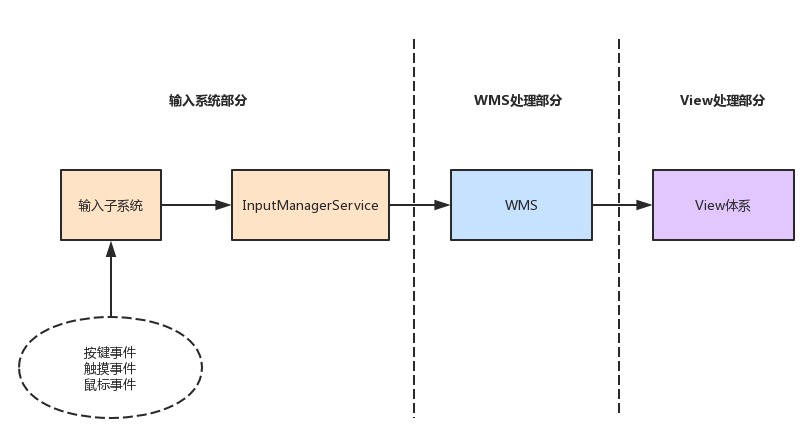
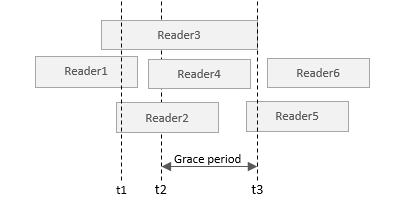
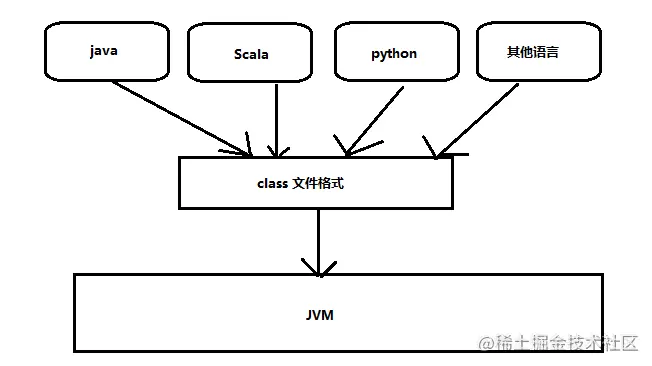
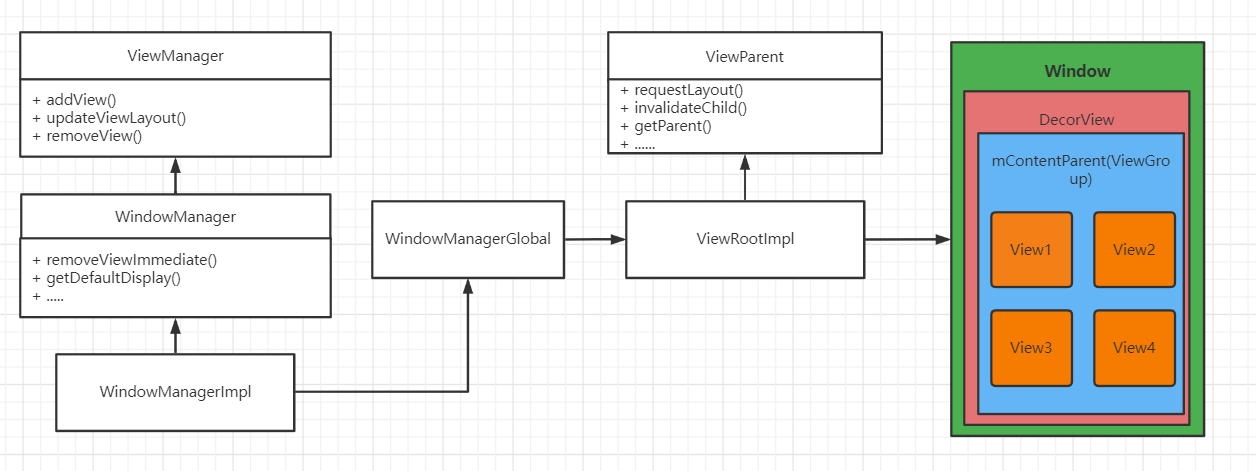
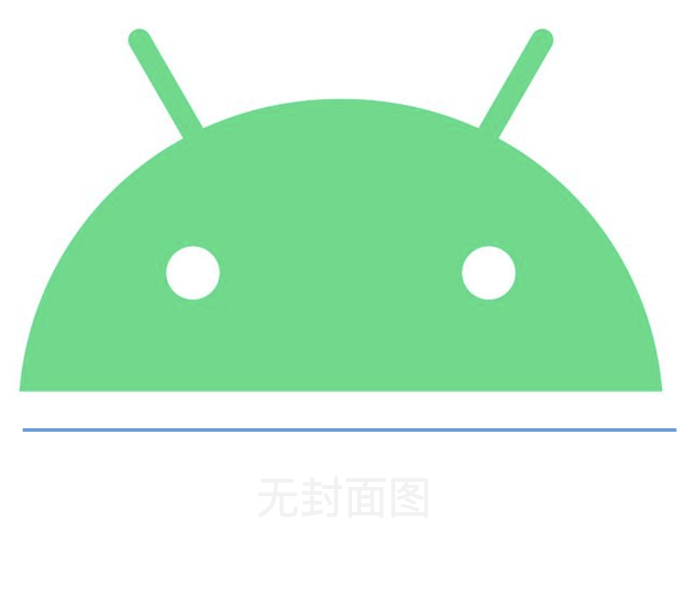
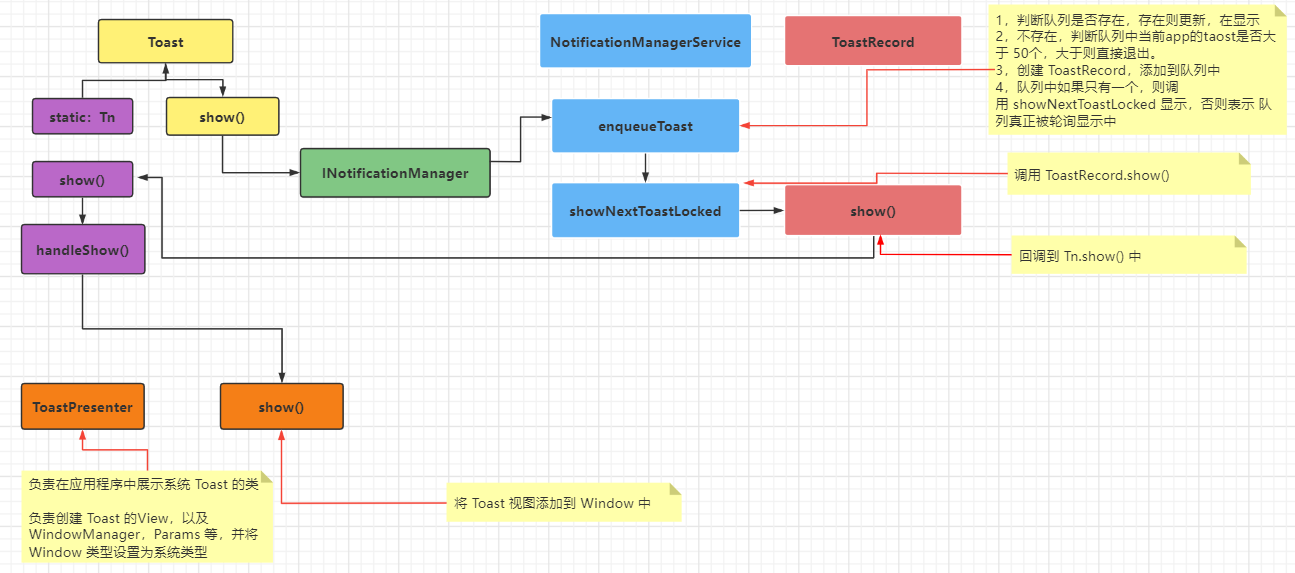

评论0